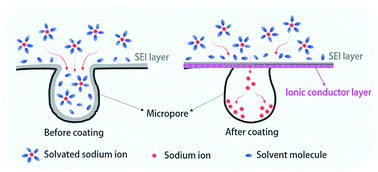An ion-conducting SnS–SnS2 hybrid coating for commercial activated carbons enabling their use as high performance anodes for sodium-ion batteries†
Abstract
Porous carbons with a high specific surface area (SSA) have been widely investigated as anodes for sodium-ion batteries (SIBs). Despite their high initial capacity, they are not ideal anodes due to the very low initial coulombic efficiency (ICE) derived from the uncontrollable irreversible reactions of the large carbon surface with the electrolyte resulting in SEI formation. In this study, an ion-conducting SnS–SnS2 hybrid coating is designed that thoroughly coats the outer surface of the porous carbon to prevent contact of the electrolyte with the inner pore surface, while allowing the diffusion of sodium ions to the inside. With an SnS–SnS2 hybrid coating, a commercial activated carbon with a high SSA of 1960 m2 g−1 shows a significant increase in ICE from 15.7% to 68.6%, and at the same time, high capacity and high rate capability are achieved. The capacities reach 380 and 110 mA h g−1 at the current densities of 0.05 and 5 A g−1, respectively. The unique design of the ion-conducting coating suggests an effective way to modify a high surface area porous carbon into a high-performance anode for metal ion batteries, not limited to SIBs.



 Please wait while we load your content...
Please wait while we load your content...